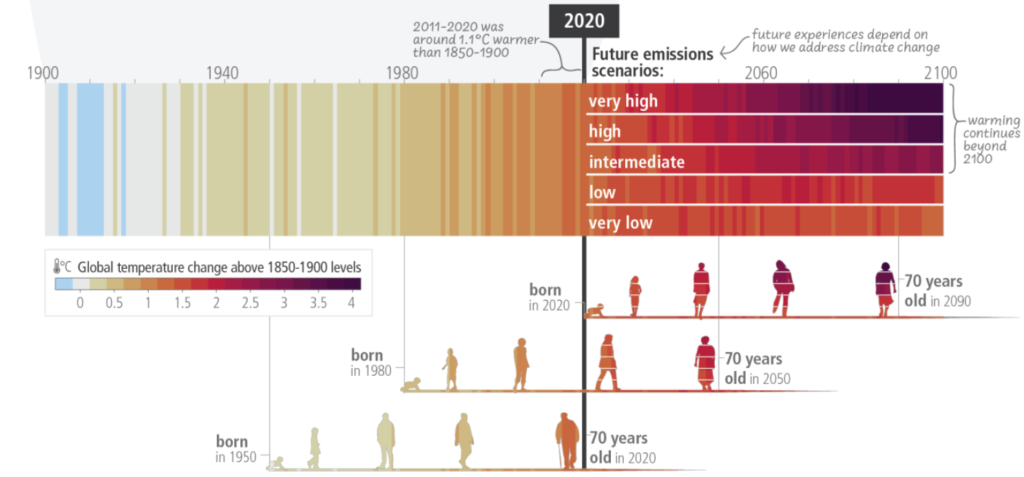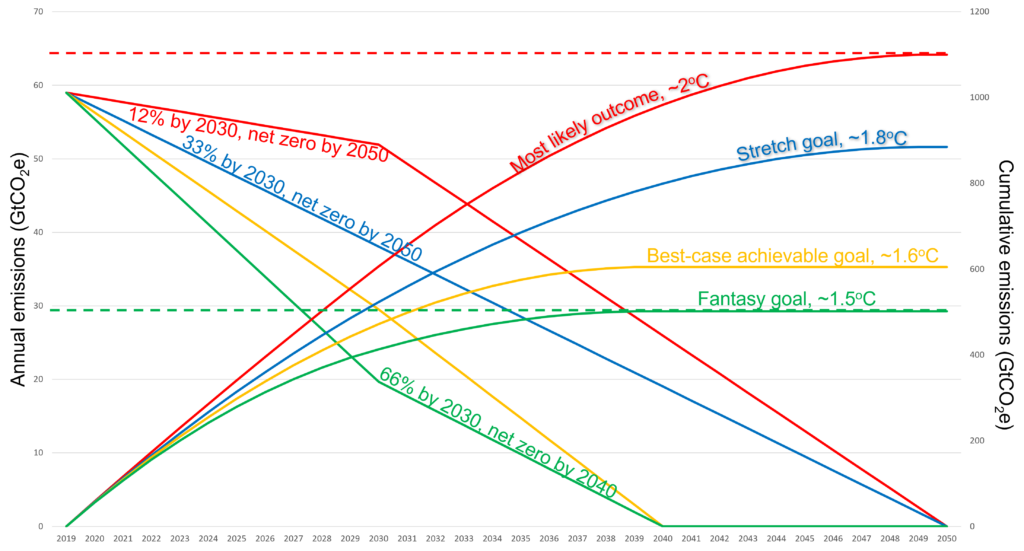
The Four Outcomes of Climate Change
By: Chandu Visweswariah
This short blog should be mandatory reading for all G7 Summit delegates in Japan. With the flurry of recent policy and scientific information, where do we stand on climate change and global warming? What are the most likely outcomes?
The chart below outlines the outcomes of global warming with impacts in this century and beyond.

The left vertical axis depicts the annual emissions of greenhouse gases (GHGs) from 2020 to 2050. All the future “drawdown” pathways start at 59 gigatons (Gt or billions of metric tons) of CO2 equivalent per year, which was the actual global emissions number for 2019 (see page 4 of the Intergovernmental Panel on Climate Change (IPCC) Assessment Report 6 (AR6) Synthesis Report, Summary for Policymakers (SYR-SPM)). The right vertical axis simply totals up the emissions from 2020 to the present for handy comparison to a “carbon budget,” which is the cumulative carbon we are allowed to “spend” from 2020 till net zero is achieved in order to stay under a prescribed amount of global warming.
Let’s examine the four future scenarios.
Fantasy goal, ~1.5oC of warming: The objective of this pathway is to meet the stretch goal of the Paris accord, i.e., to limit warming to 1.5oC with no “overshoot” above 1.5oC. This will require very steep reduction of emissions by 2030, and then achievement of net zero by 2040, as shown in the downward green line. The total carbon budget of this goal is 500Gt CO2e (see where the dotted green line intersects the right vertical axis) as per page 21 of the aforementioned IPCC report, and our chances of limiting warming to 1.5oC if we stay within this budget is 50%.
While a 50% chance of staving off the worst effects of climate change sounds attractive, this outcome is unlikely to transpire. As of 2023, our emissions are still increasing. The uptake of renewable electricity, electric vehicles and heat pumps are not as rapid as necessary. Fossil fuel exploration, new fossil fuel permits and construction of new fossil fuel plants are continuing, even in the United States. To achieve this goal, we will have to rapidly convert all electricity to renewable, all light- and medium-duty transportation to electric, and all building conditioning to heat pumps. It is a fantasy to think we can reduce emissions by 2/3 before 2030. It is a sad moment when environmentalists, climate scientists and policy makers give up on a cherished goal, but at this time the majority of experts believe that limiting warming to 1.5oC is almost impossible.
Best-case achievable goal, ~1.6oC: With a carbon budget of an extra 100 Gt CO2e (yellow pathway) we can reduce emissions at a slightly more relaxed pace of 50% by 2030 and net zero by 2040. This is the goal espoused by CURE100 (Communities United to Reduce Emissions 100%, cure100.org). It is probably fair to call this the “Best-case achievable goal.” Unfortunately, 1.6oC of warming is not a good outcome. The recent IPCC AR6 SYR-SPM (page 12) makes clear that every tenth of a degree above 1.5oC will bring serious harm and risks to the planet: “Every increment of global warming (above 1.5oC) will intensify multiple and concurrent hazards (high confidence).” For us to achieve this goal, GHG emissions have to stop increasing immediately, and we have to lower our emissions steadily from where we are today to net zero by 2040. At the same time, we have to hope and pray that we do not trigger any tipping points, and that the harms are mitigable by adaptation measures. Nonetheless, this will be a good and honorable result.
Stretch goal, ~1.8oC: The carbon budget of this goal is just under 900 Gt CO2e. To achieve this goal, we need to immediately stop increasing GHG emissions, and steadily reduce GHG emissions till we achieve net zero in 2050 as shown in the blue line, which represents decarbonization at a slightly gentler pace than the Best-case Achievable Goal. Many policy experts believe this is a doable goal if we have the will across the globe to ditch fossil fuels sooner rather than later. Unfortunately, the risks and perils of this scenario (and even more so the next one) are catastrophic, not least because of ongoing discussions at the G7 summit in Japan. Hold that thought, we will come back to it a bit later.
Most likely outcome, 2oC: With a carbon budget of 1,150 Gt CO2e (see page 21 of the IPCC AR6 SYR-SPM), this scenario gives us a 66% chance of limiting warming to 2oC. Many scientists and policy makers believe this is the most likely outcome, since it requires only modest reductions (12%) in 2030, followed by a steady decline of GHG emissions to net zero in 2050, illustrated by the red line. While this outcome is not a given, recent climate actions and pledges seem to indicate that we are gathering the necessary momentum.
A few years ago, we were discussing 3 and even 4 degrees of warming, and thankfully those frightening cataclysms are not part of the debate today. However, the harms of 1.8oC or 2oC of warming compared to 1.5oC of warming are substantial, and more serious than previously conceived. For example, at 1.5oC of warming, 70 to 90% of warm water coral reefs will be bleached and destroyed, while at 2oC, 99% destruction will occur which is possibly irreversible. Given the importance of coral reefs in the aquatic food chain, is this a risk we want to take? Another example: the number of people displaced or impacted by sea-level rise will be 10 million more with 2oC of warming compared to 1.5oC. Yet another example: past the year 2100, 2oC of warming can lead to sea-level rise of as much as 6 m (20 feet) while with 1.5oC of warming, sea-level rise will be limited to 3m (10 feet) (see page 19 of the IPCC AR6 SYR-SPM). Are these really risks we can afford to take?
The truth is that our actions in this decade will have impacts for the rest of this century and two millennia to come (see pages 20, 21, 25, 27 of the IPCC AR6 SYR-SPM).
The lead graphic of this piece is from the IPCC AR6 SYR-SPM and eloquently captures the risks our children and grandchildren will face before the end of the century and beyond. Anything above the “very low” (1.5oC of warming) including the “low” scenario (2oC of warming) looks truly frightening! Every child born in the coming decades will face dire consequences depending on our actions in this decade.
In bringing us to this juncture, our society has failed in multiple ways including our countries, the fossil fuel industry, our educational institutions, our justice systems and our politicians.
Here’s a message to our G7 delegates even as our leaders are now talking about “softening” or walking back on their carbon commitments and re-thinking the ban on coal after 2030. Dear G7 delegate, thank you for your public service. I hope you have the strength and wisdom to recognize the climate battle as the true existential war you have to fight to protect your constituents. Despite all your efforts, global carbon emissions are continuing to grow. You need to accelerate decarbonization, not re-think old commitments. If you waver or waiver at this crucial moment, you are hewing closer to the red curve (or worse) in the graph of likely outcomes (and the “intermediate” row in the lead graphic) whereby the harms to us and future generations are incalculable. I urge you to reconsider after understanding the implications of your actions. Let’s fight the true battle and let’s be smart in how we go about it.

